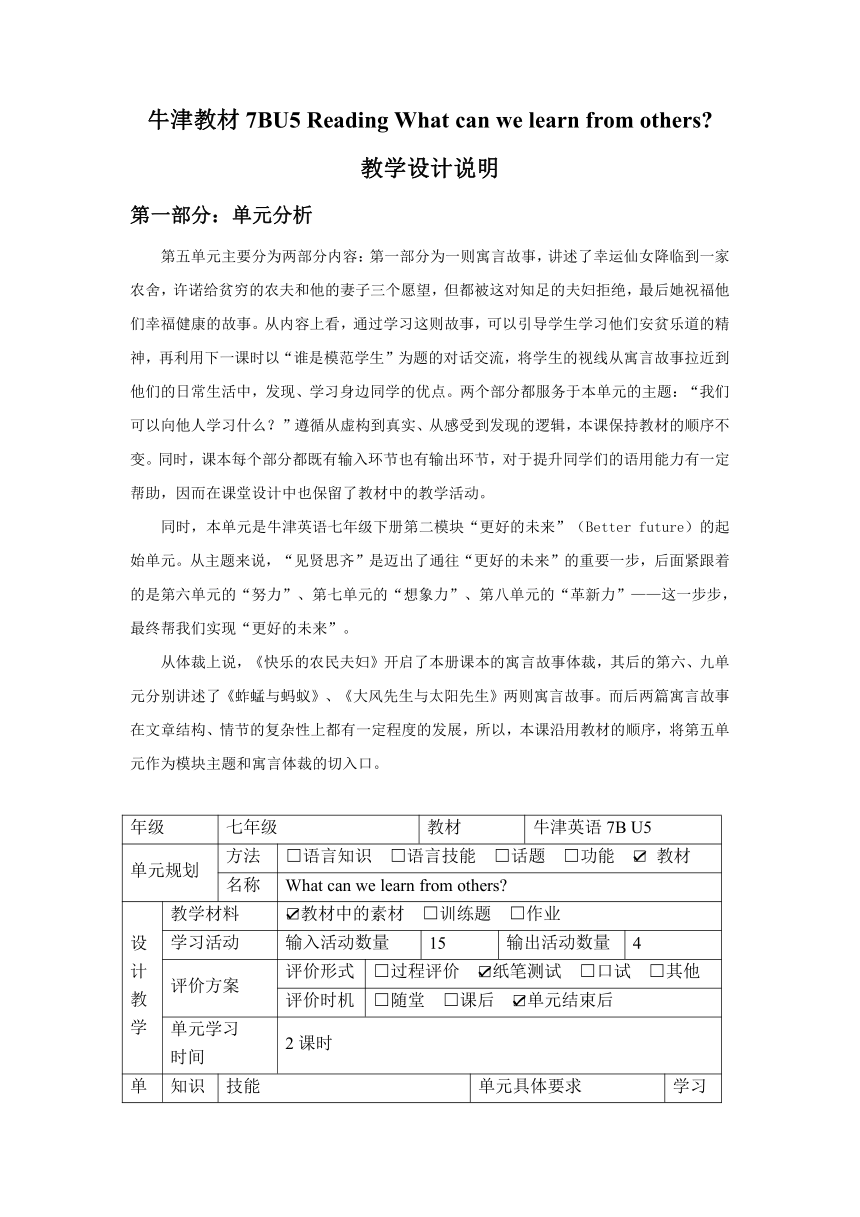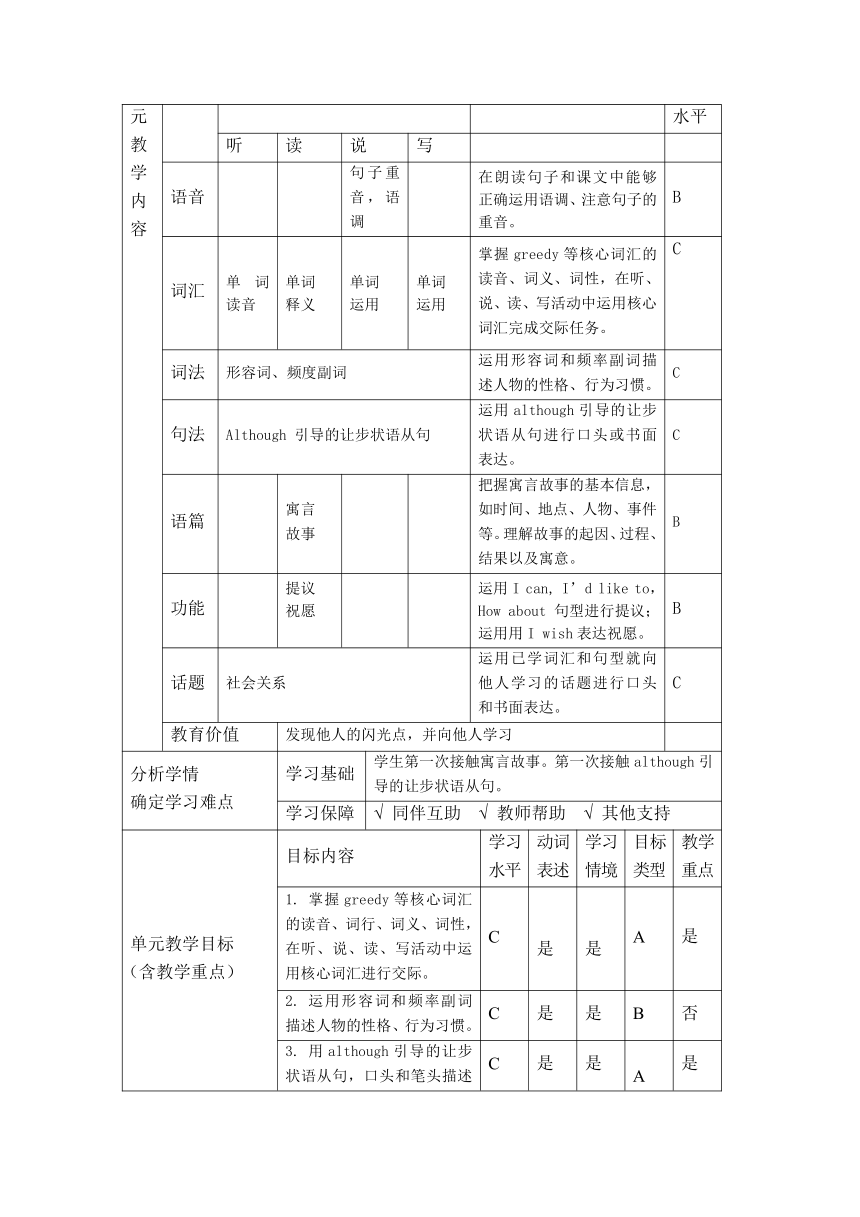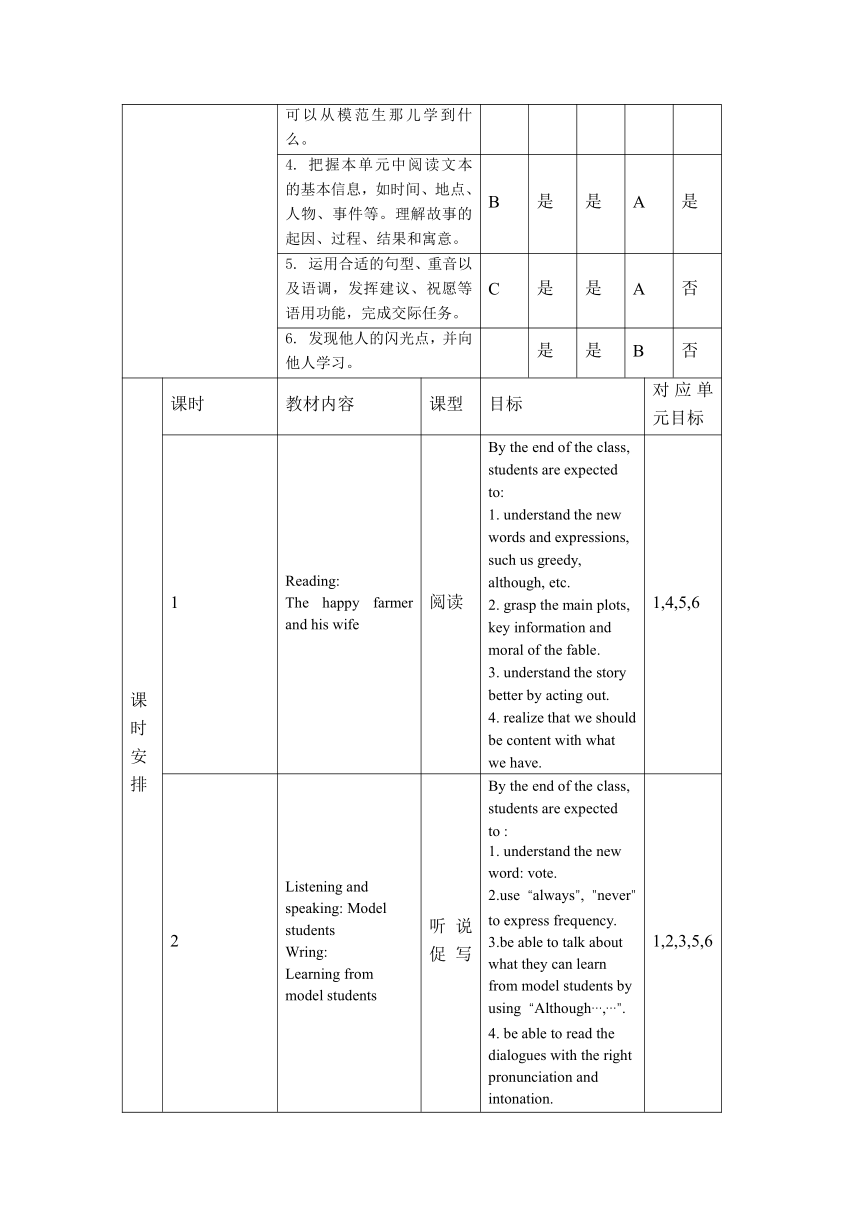牛津上海(试用本)七年级下册 Module 2 Better future Unit 5 What can we learn from others 教案
文档属性
| 名称 | 牛津上海(试用本)七年级下册 Module 2 Better future Unit 5 What can we learn from others 教案 |

|
|
| 格式 | docx | ||
| 文件大小 | 225.9KB | ||
| 资源类型 | 教案 | ||
| 版本资源 | 牛津上海版(试用本) | ||
| 科目 | 英语 | ||
| 更新时间 | 2023-05-31 17:35:50 | ||
图片预览



文档简介
牛津教材7BU5 Reading What can we learn from others
教学设计说明
第一部分:单元分析
第五单元主要分为两部分内容:第一部分为一则寓言故事,讲述了幸运仙女降临到一家农舍,许诺给贫穷的农夫和他的妻子三个愿望,但都被这对知足的夫妇拒绝,最后她祝福他们幸福健康的故事。从内容上看,通过学习这则故事,可以引导学生学习他们安贫乐道的精神,再利用下一课时以“谁是模范学生”为题的对话交流,将学生的视线从寓言故事拉近到他们的日常生活中,发现、学习身边同学的优点。两个部分都服务于本单元的主题:“我们可以向他人学习什么?”遵循从虚构到真实、从感受到发现的逻辑,本课保持教材的顺序不变。同时,课本每个部分都既有输入环节也有输出环节,对于提升同学们的语用能力有一定帮助,因而在课堂设计中也保留了教材中的教学活动。
同时,本单元是牛津英语七年级下册第二模块“更好的未来”(Better future)的起始单元。从主题来说,“见贤思齐”是迈出了通往“更好的未来”的重要一步,后面紧跟着的是第六单元的“努力”、第七单元的“想象力”、第八单元的“革新力”——这一步步,最终帮我们实现“更好的未来”。
从体裁上说,《快乐的农民夫妇》开启了本册课本的寓言故事体裁,其后的第六、九单元分别讲述了《蚱蜢与蚂蚁》、《大风先生与太阳先生》两则寓言故事。而后两篇寓言故事在文章结构、情节的复杂性上都有一定程度的发展,所以,本课沿用教材的顺序,将第五单元作为模块主题和寓言体裁的切入口。
年级 七年级 教材 牛津英语7B U5
单元规划 方法 语言知识 语言技能 话题 功能 教材
名称 What can we learn from others
设计教学 教学材料 教材中的素材 训练题 作业
学习活动 输入活动数量 15 输出活动数量 4
评价方案 评价形式 过程评价 纸笔测试 口试 其他
评价时机 随堂 课后 单元结束后
单元学习 时间 2课时
单元教学内容 知识 技能 单元具体要求 学
听 读 说 写
语音 句子重音,语调 在朗读句子和课文中能够正确运用语调、注意句子的重音。 B
词汇 单词读音 单词 释义 单词 运用 单词 运用 掌握greedy等核心词汇的读音、词义、词性,在听、说、读、写活动中运用核心词汇完成交际任务。 C
词法 形容词、频度副词 运用形容词和频率副词描述人物的性格、行为习惯。 C
句法 Although 引导的让步状语从句 运用although引导的让步状语从句进行口头或书面表达。 C
语篇 寓言 故事 把握寓言故事的基本信息,如时间、地点、人物、事件等。理解故事的起因、过程、结果以及寓意。 B
功能 提议 祝愿 运用I can, I’d like to,How about 句型进行提议; 运用用I wish表达祝愿。 B
话题 社会关系 运用已学词汇和句型就向他人学习的话题进行口头和书面表达。 C
教育价值 发现他人的闪光点,并向他人学习
分析学情 确定学习难点 学习基础 学生第一次接触寓言故事。第一次接触although引导的让步状语从句。
学习保障 √ 同伴互助 √ 教师帮助 √ 其他支持
单元教学目标 (含教学重点) 目标内容 学 动词表述 学习情境 目标类型 教学重点
掌握greedy等核心词汇的读音、词行、词义、词性,在听、说、读、写活动中运用核心词汇进行交际。 C 是 是 A 是
运用形容词和频率副词描述人物的性格、行为习惯。 C 是 是 B 否
用although引导的让步状语从句,口头和笔头描述可以从模范生那儿学到什么。 C 是 是
A 是
把握本单元中阅读文本的基本信息,如时间、地点、人物、事件等。理解故事的起因、过程、结果和寓意。 B 是 是 A 是
运用合适的句型、重音以及语调,发挥建议、祝愿等语用功能,完成交际任务。 C 是 是 A 否
发现他人的闪光点,并向他人学习。 是 是 B 否
课时安排 课时 教材内容 课型 目标 对应单元目标
1 Reading: The happy farmer and his wife 阅读 By the end of the class, students are expected to: 1. understand the new words and expressions, such us greedy, although, etc. 2. grasp the main plots, key information and moral of the fable. 3. understand the story better by acting out. 4. realize that we should be content with what we have. 1,4,5,6
2 Listening and speaking: Model students Wring: Learning from model students 听说促 写 By the end of the class, students are expected to : 1. understand the new word: vote. 2.use “always”, ”never” to express frequency. 3.be able to talk about what they can learn from model students by using “Although…,…”. 4. be able to read the dialogues with the right pronunciation and intonation. 5. be aware that everyone has his good points and can be a model for others. 1,2,3,5,6
第二部分:主题思考、文本分析
本课是牛津教材7B Unit5中的Reading: The happy farmer and his wife, 课型为阅读课。
从文本角度来看,本篇文章为童话故事,人物设定清晰、情节简单。文章总共分文八段,第一段介绍了时间、地点、人物、起因,第二段到第九段以幸运仙子和农民夫妇之间的对话展开,上演了“four proposals, four refusals” (“四提四拒”)的情节,最后一段幸运仙子终于“罢休”,在祝福他们幸福、健康之后消失了。文本旨在引导读者学会知足常乐。
从文体特征来看,文章的四幅插图则在学生理解文本是起了很好的辅助作用,可以在预测文章内容、学习词汇、梳理文章脉络、表演输出时好好加以利用。文章的标题为“The happy farmer and his wife”。可以引导同学们根据学习文章后基于自己的理解,重新选定标题,以期锻炼他们的总结概况能力和创造力。
从话题来看,在9年级的牛津教材中,出现了相同母题下的另一则寓言故事《渔夫和他的妻子》。两则故事背景一致,却因为人物的性格、做出的选择产生了强烈的反差式的结果,比较阅读后相信同学们会有更多的收获。而兼顾低年级同学的年龄特点和学情,不宜直接引入《渔夫和他的妻子》这篇长而难的文章,因此课后作业的More Reading选择了《初中阅读新思维》一书中简写版的《渔夫和他的妻子》,并且建议同学们观看《渔夫和他的妻子》动画短片,轻松有趣,寓教于乐。
第三部分:教学目标
By the end of the class, students are expected to:
understand the new words and expressions, such us greedy, although, etc.
grasp the main plots, key information and moral of the fable.
act out stories with the guidance of checklist.
realize that we should be content with what we have.
第四部分:教学重难点
Teaching focus:
To guide Ss to grasp the main plots, key information and moral of the story.
Students’ potential difficulty in learning:
To create new titles for the story based on their understanding of the moral.
第五部分:教学流程
Stages Learning activities Purposes
Pre-reading ‘Read’ an illustration from the text book and tell ‘when, where, who, what’ To help Ss find out or predict some details of the story.
While-reading Read the first paragraph and find out more about ‘when, where, who, what’; Learn the new words: hut, fairy Read paragraph 2 and answer three questions: - Why did the Luck Fairy visit them - Why did she want to do that - Would Fred accept the three wishes Check their prediction and analyze why the characters did so; Learn the new sentence pattern: adverbial clause of concession with “although” Skim paragraph 4-9 and answer: - What did the Fairy suggest to give them then - Did they accept them Scan paragraph 4-9 and complete a table; Learn new words: gold coins, earn, reply, comfortable; Conclude the sentence pattern we can use to refuse proposals politely (the adverbial clause of concession with “although” ) Read in roles Read paragraph 10 and answer three questions: - What did the Fairy wish them at last Why - What happened in the end Learn new words: wish sb. sth., happiness, forever, greedy, disappear Imagine what would Fred and Doris say before the Luck Fairy disappeared Think about what they can learn from Fred and Doris To help Ss check and enhance their understanding of the setting. To guide Ss to find some key information and predict the development of the story from their understanding of the characters. To let Ss understand the plot. To guide Ss to grasp the main plots of the story. To guide Ss to get some key information of the story; To help Ss understand when to use an adverbial clause of “although” and its meaning To help the Ss practice their stress, intonation and lines. To guide Ss to understand the ending and learn some new expressions To make the story more complete To guide the Ss to think about the moral of the story
Post-reading Think and answer: If the Luck Fairy visits your house one night and would like to give you high scores in tests/ good memory/ a smart phone, will you accept it Why or why not Act it out: Get informed with the tips for their acting and decide their roles in the play Rehearse for 4-5 minutes Some groups act the story out Think and say: Can you think of a title for this story The _________ (adj.) farmer and his wife Never be ________(adj.) Learn to be _________ (adj.) The Luck Fairy “__________” (v.) Back to the topic of this unit and the whole chapter To involve Ss into the situation and guide them to use “although” to refuse proposals To help the students walk in the shoes of the characters and enhance their understanding of the story while acting and watching. To guide the Ss to use the key information and moral of the story to conclude the whole story; to enhance their understanding of the whole story To guide the Ss to understand the story’s position in the whole unit and the unit’s position in whole module;
Assignments U5 Exercise 1 & 2 (vocabulary, grammar + more reading)
第六部分:课堂学习单
Worksheet for U5P1
Reading: The happy farmer and his wife
Read and complete the table:
proposals (提议) reasons of proposals replies (means answers)
three wishes Because they are good and hardworking. (look: smiled at each other) ‘Although we’re old, we work in the fields every day.’
_______________ Because they don’t _________________. ‘_____________ we’re poor, we live _____________.’
a big new house Because their ______ is ________ and _________. ‘Although..., it’s very _____________. I _______ this hut very much. I_________________ here with Doris for many years.’
Some beautiful clothes Because their clothes are __________. ‘Although our clothes are old, they’re still ____________. They keep us ___________ in winter’
Act it out
Checklist 1: for the story on the book
Checklist 1
Remember the plots (情节) and naturally act them out.
Sound like and act like who they are.
Add some lines (台词), body moves (身体动作) and looks (表情).
Checklist 2: for your own story
Checklist 2
The plots (情节) are creative and logical (有逻辑的).
Sound like and act like who they are.
Add some lines (台词), body moves (身体动作) and looks (表情).
教学设计说明
第一部分:单元分析
第五单元主要分为两部分内容:第一部分为一则寓言故事,讲述了幸运仙女降临到一家农舍,许诺给贫穷的农夫和他的妻子三个愿望,但都被这对知足的夫妇拒绝,最后她祝福他们幸福健康的故事。从内容上看,通过学习这则故事,可以引导学生学习他们安贫乐道的精神,再利用下一课时以“谁是模范学生”为题的对话交流,将学生的视线从寓言故事拉近到他们的日常生活中,发现、学习身边同学的优点。两个部分都服务于本单元的主题:“我们可以向他人学习什么?”遵循从虚构到真实、从感受到发现的逻辑,本课保持教材的顺序不变。同时,课本每个部分都既有输入环节也有输出环节,对于提升同学们的语用能力有一定帮助,因而在课堂设计中也保留了教材中的教学活动。
同时,本单元是牛津英语七年级下册第二模块“更好的未来”(Better future)的起始单元。从主题来说,“见贤思齐”是迈出了通往“更好的未来”的重要一步,后面紧跟着的是第六单元的“努力”、第七单元的“想象力”、第八单元的“革新力”——这一步步,最终帮我们实现“更好的未来”。
从体裁上说,《快乐的农民夫妇》开启了本册课本的寓言故事体裁,其后的第六、九单元分别讲述了《蚱蜢与蚂蚁》、《大风先生与太阳先生》两则寓言故事。而后两篇寓言故事在文章结构、情节的复杂性上都有一定程度的发展,所以,本课沿用教材的顺序,将第五单元作为模块主题和寓言体裁的切入口。
年级 七年级 教材 牛津英语7B U5
单元规划 方法 语言知识 语言技能 话题 功能 教材
名称 What can we learn from others
设计教学 教学材料 教材中的素材 训练题 作业
学习活动 输入活动数量 15 输出活动数量 4
评价方案 评价形式 过程评价 纸笔测试 口试 其他
评价时机 随堂 课后 单元结束后
单元学习 时间 2课时
单元教学内容 知识 技能 单元具体要求 学
听 读 说 写
语音 句子重音,语调 在朗读句子和课文中能够正确运用语调、注意句子的重音。 B
词汇 单词读音 单词 释义 单词 运用 单词 运用 掌握greedy等核心词汇的读音、词义、词性,在听、说、读、写活动中运用核心词汇完成交际任务。 C
词法 形容词、频度副词 运用形容词和频率副词描述人物的性格、行为习惯。 C
句法 Although 引导的让步状语从句 运用although引导的让步状语从句进行口头或书面表达。 C
语篇 寓言 故事 把握寓言故事的基本信息,如时间、地点、人物、事件等。理解故事的起因、过程、结果以及寓意。 B
功能 提议 祝愿 运用I can, I’d like to,How about 句型进行提议; 运用用I wish表达祝愿。 B
话题 社会关系 运用已学词汇和句型就向他人学习的话题进行口头和书面表达。 C
教育价值 发现他人的闪光点,并向他人学习
分析学情 确定学习难点 学习基础 学生第一次接触寓言故事。第一次接触although引导的让步状语从句。
学习保障 √ 同伴互助 √ 教师帮助 √ 其他支持
单元教学目标 (含教学重点) 目标内容 学 动词表述 学习情境 目标类型 教学重点
掌握greedy等核心词汇的读音、词行、词义、词性,在听、说、读、写活动中运用核心词汇进行交际。 C 是 是 A 是
运用形容词和频率副词描述人物的性格、行为习惯。 C 是 是 B 否
用although引导的让步状语从句,口头和笔头描述可以从模范生那儿学到什么。 C 是 是
A 是
把握本单元中阅读文本的基本信息,如时间、地点、人物、事件等。理解故事的起因、过程、结果和寓意。 B 是 是 A 是
运用合适的句型、重音以及语调,发挥建议、祝愿等语用功能,完成交际任务。 C 是 是 A 否
发现他人的闪光点,并向他人学习。 是 是 B 否
课时安排 课时 教材内容 课型 目标 对应单元目标
1 Reading: The happy farmer and his wife 阅读 By the end of the class, students are expected to: 1. understand the new words and expressions, such us greedy, although, etc. 2. grasp the main plots, key information and moral of the fable. 3. understand the story better by acting out. 4. realize that we should be content with what we have. 1,4,5,6
2 Listening and speaking: Model students Wring: Learning from model students 听说促 写 By the end of the class, students are expected to : 1. understand the new word: vote. 2.use “always”, ”never” to express frequency. 3.be able to talk about what they can learn from model students by using “Although…,…”. 4. be able to read the dialogues with the right pronunciation and intonation. 5. be aware that everyone has his good points and can be a model for others. 1,2,3,5,6
第二部分:主题思考、文本分析
本课是牛津教材7B Unit5中的Reading: The happy farmer and his wife, 课型为阅读课。
从文本角度来看,本篇文章为童话故事,人物设定清晰、情节简单。文章总共分文八段,第一段介绍了时间、地点、人物、起因,第二段到第九段以幸运仙子和农民夫妇之间的对话展开,上演了“four proposals, four refusals” (“四提四拒”)的情节,最后一段幸运仙子终于“罢休”,在祝福他们幸福、健康之后消失了。文本旨在引导读者学会知足常乐。
从文体特征来看,文章的四幅插图则在学生理解文本是起了很好的辅助作用,可以在预测文章内容、学习词汇、梳理文章脉络、表演输出时好好加以利用。文章的标题为“The happy farmer and his wife”。可以引导同学们根据学习文章后基于自己的理解,重新选定标题,以期锻炼他们的总结概况能力和创造力。
从话题来看,在9年级的牛津教材中,出现了相同母题下的另一则寓言故事《渔夫和他的妻子》。两则故事背景一致,却因为人物的性格、做出的选择产生了强烈的反差式的结果,比较阅读后相信同学们会有更多的收获。而兼顾低年级同学的年龄特点和学情,不宜直接引入《渔夫和他的妻子》这篇长而难的文章,因此课后作业的More Reading选择了《初中阅读新思维》一书中简写版的《渔夫和他的妻子》,并且建议同学们观看《渔夫和他的妻子》动画短片,轻松有趣,寓教于乐。
第三部分:教学目标
By the end of the class, students are expected to:
understand the new words and expressions, such us greedy, although, etc.
grasp the main plots, key information and moral of the fable.
act out stories with the guidance of checklist.
realize that we should be content with what we have.
第四部分:教学重难点
Teaching focus:
To guide Ss to grasp the main plots, key information and moral of the story.
Students’ potential difficulty in learning:
To create new titles for the story based on their understanding of the moral.
第五部分:教学流程
Stages Learning activities Purposes
Pre-reading ‘Read’ an illustration from the text book and tell ‘when, where, who, what’ To help Ss find out or predict some details of the story.
While-reading Read the first paragraph and find out more about ‘when, where, who, what’; Learn the new words: hut, fairy Read paragraph 2 and answer three questions: - Why did the Luck Fairy visit them - Why did she want to do that - Would Fred accept the three wishes Check their prediction and analyze why the characters did so; Learn the new sentence pattern: adverbial clause of concession with “although” Skim paragraph 4-9 and answer: - What did the Fairy suggest to give them then - Did they accept them Scan paragraph 4-9 and complete a table; Learn new words: gold coins, earn, reply, comfortable; Conclude the sentence pattern we can use to refuse proposals politely (the adverbial clause of concession with “although” ) Read in roles Read paragraph 10 and answer three questions: - What did the Fairy wish them at last Why - What happened in the end Learn new words: wish sb. sth., happiness, forever, greedy, disappear Imagine what would Fred and Doris say before the Luck Fairy disappeared Think about what they can learn from Fred and Doris To help Ss check and enhance their understanding of the setting. To guide Ss to find some key information and predict the development of the story from their understanding of the characters. To let Ss understand the plot. To guide Ss to grasp the main plots of the story. To guide Ss to get some key information of the story; To help Ss understand when to use an adverbial clause of “although” and its meaning To help the Ss practice their stress, intonation and lines. To guide Ss to understand the ending and learn some new expressions To make the story more complete To guide the Ss to think about the moral of the story
Post-reading Think and answer: If the Luck Fairy visits your house one night and would like to give you high scores in tests/ good memory/ a smart phone, will you accept it Why or why not Act it out: Get informed with the tips for their acting and decide their roles in the play Rehearse for 4-5 minutes Some groups act the story out Think and say: Can you think of a title for this story The _________ (adj.) farmer and his wife Never be ________(adj.) Learn to be _________ (adj.) The Luck Fairy “__________” (v.) Back to the topic of this unit and the whole chapter To involve Ss into the situation and guide them to use “although” to refuse proposals To help the students walk in the shoes of the characters and enhance their understanding of the story while acting and watching. To guide the Ss to use the key information and moral of the story to conclude the whole story; to enhance their understanding of the whole story To guide the Ss to understand the story’s position in the whole unit and the unit’s position in whole module;
Assignments U5 Exercise 1 & 2 (vocabulary, grammar + more reading)
第六部分:课堂学习单
Worksheet for U5P1
Reading: The happy farmer and his wife
Read and complete the table:
proposals (提议) reasons of proposals replies (means answers)
three wishes Because they are good and hardworking. (look: smiled at each other) ‘Although we’re old, we work in the fields every day.’
_______________ Because they don’t _________________. ‘_____________ we’re poor, we live _____________.’
a big new house Because their ______ is ________ and _________. ‘Although..., it’s very _____________. I _______ this hut very much. I_________________ here with Doris for many years.’
Some beautiful clothes Because their clothes are __________. ‘Although our clothes are old, they’re still ____________. They keep us ___________ in winter’
Act it out
Checklist 1: for the story on the book
Checklist 1
Remember the plots (情节) and naturally act them out.
Sound like and act like who they are.
Add some lines (台词), body moves (身体动作) and looks (表情).
Checklist 2: for your own story
Checklist 2
The plots (情节) are creative and logical (有逻辑的).
Sound like and act like who they are.
Add some lines (台词), body moves (身体动作) and looks (表情).
同课章节目录
- Module 1 Garden City and its neighbours
- Unit 1 Writing a travel guide
- Unit 2 Going to see a film
- Unit 3 A visit to Garden City
- Module 2 Better future
- Unit 4 Let's go shopping
- Unit 5 What can we learn from others?
- Unit 6 Hard work for a better life
- Unit 7 in the future
- Module 3 The natural elements
- Unit 8 A more enjoyable school life
- Unit 9 The wind is blowing
- Unit 10 Water Festival
- Unit 11 Electricity
